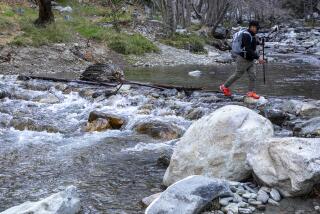A Walk in the Footsteps and Folkways of the Chumash
Satwiwa Native American Natural Area in the Santa Monica Mountains offers a chance to explore a place where Chumash walked for thousands of years before Europeans arrived on the scene. A visitor center and guest speakers help hikers learn the habits of wildlife, the changes the seasons bring, and the ceremonies that kept--and still keep--the Chumash bonded to the earth.
For hunter-gatherers, as anthropologists call them, this land on the wild west end of the Santa Monicas was truly bountiful with seeds, roots, bulbs, berries, acorns and black walnuts. Birds, deer and squirrels were plentiful, as were fish and shellfish from nearby Mugu Lagoon. It was this abundant food supply that helped the Chumash become the largest tribal group in California at the time of Cabrillo’s arrival in 1542.
Chumash territory ranged from Topanga Canyon, near the east end of the Santa Monicas, all the way up the coast to San Luis Obispo and out to the Channel Islands. Satwiwa means “the bluffs” and was the name of a Chumash settlement located at this end of the Santa Monica Mountains.
The name of this park site, Rancho Sierra Vista/Satwiwa, reflects its history as both a longtime (1870s to 1970s) horse and cattle ranch and the ancestral land of the Chumash. Many visitors are surprised to learn of the extent of Chumash settlement and even more surprised to be greeted by a Chumash guide and find out they’re not just museum relics.
The National Park Service prefers to call Satwiwa a culture center rather than a museum in order to keep the emphasis on living Native Americans. Satwiwa Native American Indian Culture Center, operated by Friends of Satwiwa in association with the National Park Service, is open Saturday and Sunday, 10 a.m. to 5 p.m. The park service decided not to interpret the loop trail through Satwiwa with plant ID plaques and brochures; instead of the usual natural history lessons, it’s hoped that hikers will come away with a more spiritual experience of the land.
This month the Santa Monica Mountains National Recreation Area celebrates its 20th anniversary. Perhaps an ideal way to celebrate is with a hike around one of the area’s premier landscapes.
And also this month, the National Park Service opens a new park entry lane off Lynn Road as well as a large day-use parking lot and a new trail head. These improvements make accessing the trail systems of Rancho Sierra Vista/Satwiwa and adjacent Point Mugu State Park a bit easier.
Directions to trail head: From U.S. 101 in Newbury Park, exit on Wendy Drive and head south a short mile to Borchard Road. Turn right, go 0.5 mile to Reino Road.
Turn left and proceed 1.2 miles to Lynn Road, turn right and continue another 1.2 miles to the park entrance road (Via Goleta) on the south side of the road opposite the Dos Vienta housing development.
The new paved park road passes an equestrian parking area on the right and a small day use parking lot on the left before dead-ending at a large, brand-new parking lot 0.7 mile from Lynn Road.
The hike: From the parking lot, follow the signed footpath a short quarter mile to the Satwiwa Native American Indian Culture Center. Signed Satwiwa Loop Trail begins its clockwise journey by leading past an old cattle pond, which is now a haven for waterfowl and wildlife.
The path then crosses a landscape in transition--from grazing land back to native grasses and wildflowers. You’ll pass a junction with Wendy Trail, a pathway that connects the Satwiwa area with Wendy Drive.
Next the trail traverses a narrow, oak-filled ravine, then ascends to an old windmill. From the trail’s high point near the windmill, the hiker gains excellent vistas to the north of Conejo Valley and scattered suburbs. To the west lies a cone-shaped prominence, 1,814-foot Conejo Mountain.
Dominating the view to the south is Boney Mountain, a series of sheer cliffs and some of the highest peaks in the Santa Monica Mountains. Shamans gathered some of their power from Boney Mountain, still considered a sanctuary by the Chumash.
Satwiwa Loop Trail descends to a junction with Hidden Valley Connector Trail (an opportunity to extend your hike to a waterfall or other destinations in Point Mugu State Park). The loop trail descends back to the culture center.
Hiking/Santa Monica Mountains
Satwiwa Loop Trail
WHERE: Rancho Sierra Vista/Satwiwa.
TERRAIN: Rugged western end of the Santa Monica Mountains.
HIGHLIGHTS: New park entrance, Satwiwa Native American Indian Culture Center.
DISTANCE: Loop Trail is 1.5 miles round trip with 200-foot elevation gain; to waterfall is 5.6 miles round trip. From parking area, add 0.5 mile round trip to all hikes.
DEGREE OF DIFFICULTY: Easy-moderate.
FOR MORE INFORMATION: Santa Monica Mountains National Recreation Area headquarters/visitor center, 401 W. Hillcrest Drive, Thousand Oaks, CA 91360; tel. (805) 370-2301.
(BEGIN TEXT OF INFOBOX / INFOGRAPHIC)
Satwiwa Loop Trail
WHERE: Rancho Sierra Vista/Satwiwa.
DISTANCE: Loop Trail is 1.5 miles round trip with 200-foot elevation gain; to waterfall is 5.6 miles round trip. From parking area, add 0.5 mile round trip to all hikes.
TERRAIN: Rugged western end of the Santa Monica Mountains.
HIGHLIGHTS: New park entrance, Satwiwa Native American Indian Culture Center.
DEGREE OF DIFFICULTY: Easy-moderate.
FOR MORE INFORMATION: Santa Monica Mountains National Recreation Area headquarters/visitor center, 401 W. Hillcrest Drive, Thousand Oaks, CA 91360; tel. (805) 370-2301.
More to Read
Sign up for The Wild
We’ll help you find the best places to hike, bike and run, as well as the perfect silent spots for meditation and yoga.
You may occasionally receive promotional content from the Los Angeles Times.






